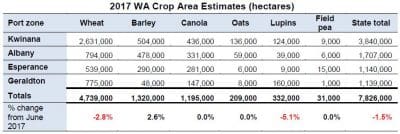WESTERN Australia’s predicted winter crop plantings have dropped a further 1.5 per cent over the past month with wheat and lupin hectares falling back from earlier projections.
Barley is the only crop to have shown a slight rise on earlier forecasts, while canola, oats and field pea projections have remained unchanged.
 The latest crop report from the Grain Industry Association of Western Australia (GIWA) says June winter rainfall has been much lower than average and there has been inconsistency in growing season rainfall across the grainbelt, in particular being significantly lower in the north and eastern grain growing regions of the state.
The latest crop report from the Grain Industry Association of Western Australia (GIWA) says June winter rainfall has been much lower than average and there has been inconsistency in growing season rainfall across the grainbelt, in particular being significantly lower in the north and eastern grain growing regions of the state.
With the season looking so patchy and areas still waiting on good rains, the total grain production for Western Australia is going to be down significantly on the record harvest achieved in 2016.
At this stage, GIWA estimates the total 2017 harvest to be within a range of 10 to 12 million tonnes.
Rainfall over the last weeks of June turned the season around in the western Kwinana and Albany port zones.
These zones now have the potential of at least average grain yields for this harvest.
The Esperance port zone is on track for above average cereal grain yields and at least average canola grain yields.
The recent rainfall events did not reach the north and eastern Geraldton port zone and the north and eastern Kwinana port zone.
These regions still have large areas of land where crop has not emerged.
At this stage, around 30 per cent of intended crop area in the Geraldton port zone will not be harvested and about 10pc of intended crop area in the north and eastern Kwinana port zone will not be harvested.
The Department of Primary Industries and Regional Development (DPIRD) reports that ‘much of the northern and central regions have received less than 20pc of normal rainfall since April’.
Pasture production has been very poor across all port zones of the State and growers are faced with the prospect of hand feeding livestock for several more months. Consequently, the large volume of feed grain stored on farm from the 2016 harvest is expected to be run down to low levels by the start of the 2017 harvest.
Source: GIWA

HAVE YOUR SAY